To coincide with his current exhibition at DJCAD, artist William Latham offers an overview of his creative life and work so far.
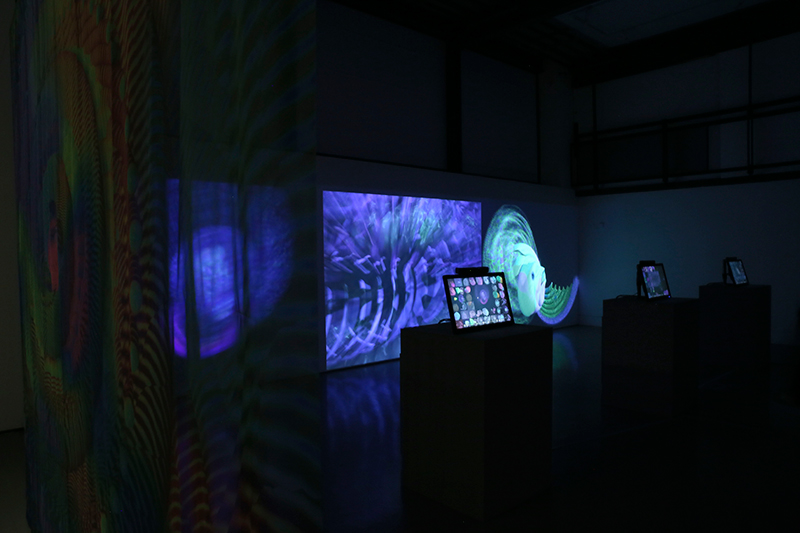
Mutator 2 (Triptych), William Latham, Centrespace, VRC, 2014
Photo: Kathryn Rattray
I work between Goldsmiths College Computing Department, where I’ve been Professor of Computer Art since 2007, and my studio at my home in Hove.
Originally I trained as an artist at The Ruskin School of Drawing (Oxford University) and at the Royal College of Art, before moving into the computing industry and becoming a Research Fellow at The IBM UK Scientific Centre in Winchester in 1987. Between 1994 and 2003, I founded and led the leading games developer Computer Artworks Ltd who produced games such as The THING (Playstation2, Xbox and PC) for Universal Studios, which became a Number 1 hit in the UK and Germany.
Now, I am working with long-term collaborator, mathematician Stephen Todd again. During the past five years we have re-engineered and extended our original FormGrow and Mutator Code from the 80s and 90s to work on the newest platforms in installation pieces, videos and photographic works. These new works stem from my experiences working in Bioinformatics, Neuroscience and Games development.
While I studied at RCA I began to devise an evolutionary rule-based drawing system that would generate organic rather than geometric forms. I called the system FormSynth (short for Form Synthesis). This system uses transforms such as “Bulge”, “Beak”, “Stretch” and “Scoop,” which define how to distort or sculpt 3D forms starting from geometric primitives to evolve increasingly complex forms with each transform step recorded and laid out in large evolutionary tree drawings. Some of these early works are currently in the exhibition Mutator 2 in Centrespace, VRC.
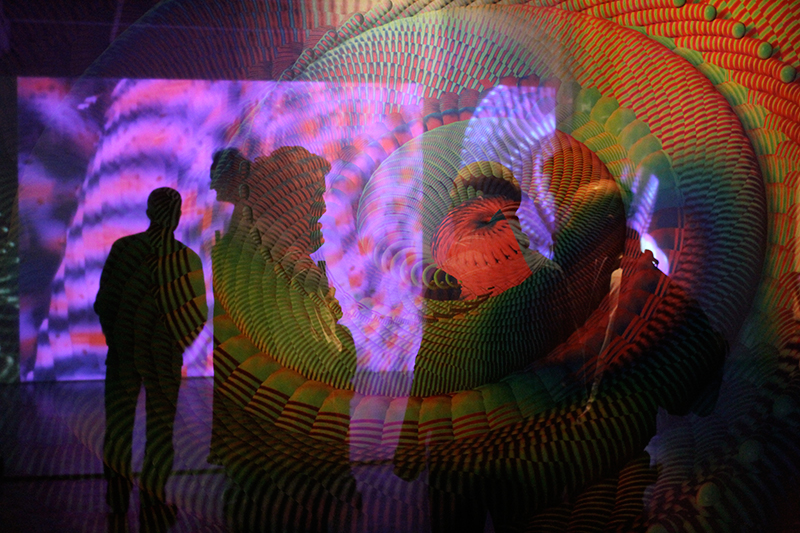
Mutator 1 + 2 : Evolutionary Art exhibition by William Latham at iMAL – Center for Digital Cultures and Technology, 2013
It was at IBM that I started working with Stephen Todd and Peter Quarendon, who importantly had developed an excellent CSG Computer Solid Geometry Modelling System called WINSOM that handled the core 3D Rendering texturing and lighting necessary for early development of the Mutator Code. Starting with the original FormSynth rules from the RCA, we gradually started to adapt the rules to produce “Horn-like forms”, resembling twisted strange animal horns. As time went on, we extended the programming grammar, which we called FormGrow, to include new transforms such as “Bend”, “Twist”, “Stack”, “Branch”, “Ribcage” and “Web” and as this grammar grew more complex and rich the 3D forms generated became more and more natural looking.
This work became the early predecessor to Mutator2 Software which works with auto-aesthetic selection, meaning the viewer has the power to interact with the forms and determine visual outcomes based upon the wide ranging possibilities of the code.
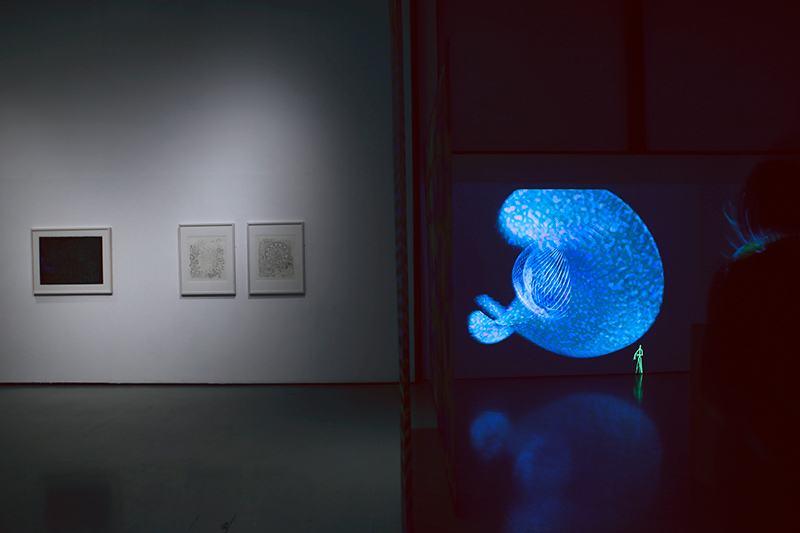
William Latham: Mutator 2, Centrespace, VRC, 2014
Photo: Kathryn Rattray
I take inspiration from the natural world (including fungi, sea urchins, jelly fish, viruses, octopuses), sci-fi movies, paisley patterns, William Morris, heavy metal imagery, D’Arcy Thompson, and Surrealist Art (Dali, Magritte, Tanguy).
Initially my work at RCA was heavily influenced by Russian Constructivism, Pop Art and Process Art and by contact with artists such as Kenneth Martin, Mary Kelly and Eduardo Paolozzi, who became a mentor for many years. I still find these areas of interest relevant today.
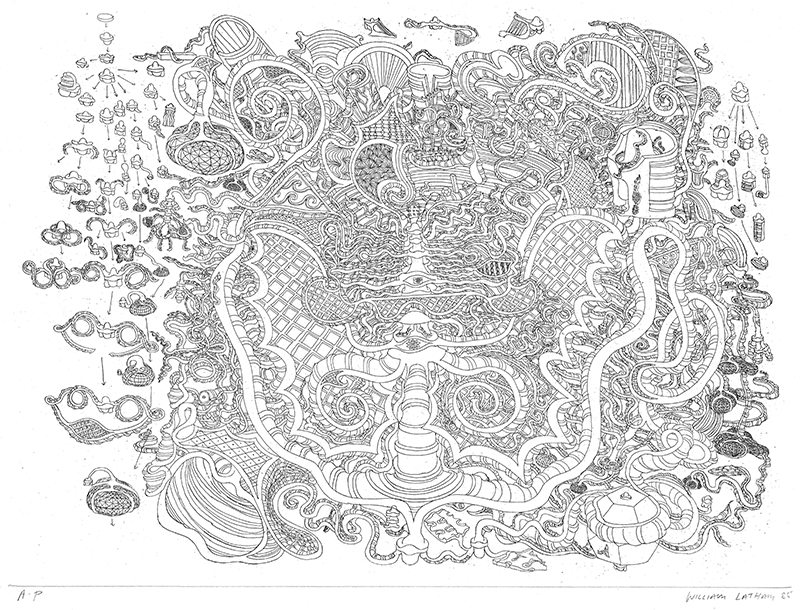
Oriental Etching FormSynth, print, William Latham, 1985
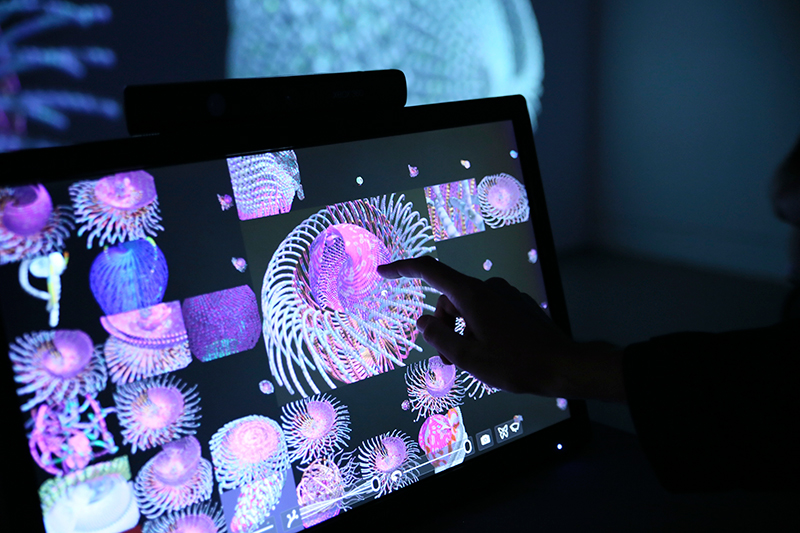
Mutator 2 (Triptych), William Latham, Centrespace, VRC, 2014
Photo: Kathryn Rattray
My current Mutator 1 + 2 show will continue to tour the UK next year. To date, the exhibition has been exhibited in Phoenix Brighton, as part of Brighton Digital Arts Festival, and in iMAL Center For Digital Cultures in Brussels. Mutator 2 at Centrespace, Visual Research Centre in Dundee continues until 31 January 2015 and shows a subset of works from the larger touring show.
Next year I’ll be visiting Korea to explore venues for future exhibitions of my work.
It is great to be exhibiting my art regularly again, which I stopped doing whilst working in the games and music industries for about twelve years when I “disappeared off the radar”. Showing my work again also coincides with a wider public appreciation of digital art which up to this time arguably has had a hostile reception from the mainstream gallery/auction house world even though photography and video art have long been accepted as an art form, with computer art being labelled a craft at best. There would appear also to be a strong resurgence of interest in my work going back to the mid eighties including my drawings, which is pleasing.
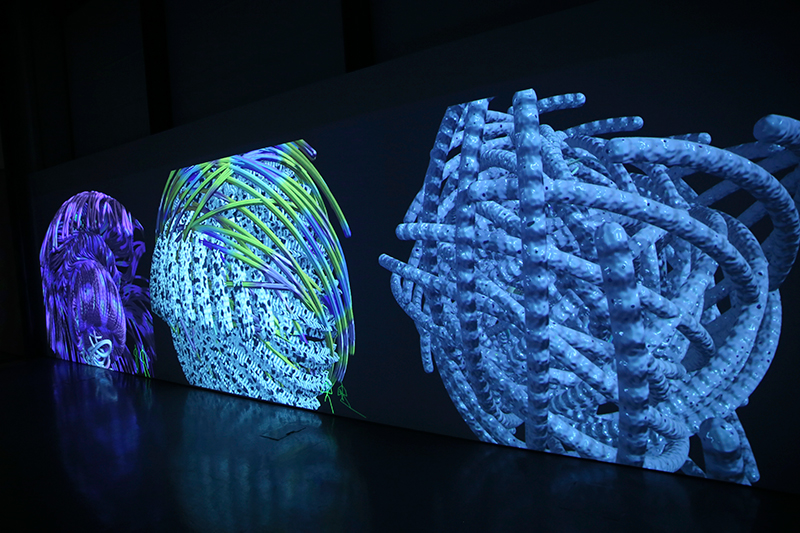
Mutator 2 (Triptych), William Latham, Centrespace, VRC, 2014
Photo: Kathryn Rattray
I’ve recently launched a new website which catalogues my practice and work. The website was curated by The Phoenix Gallery Brighton, funded and supported by The Arts Council of England, and coincided with my solo show Mutator 1 + 2 at the Phoenix Gallery.
I co-curated Creative Machine, an exhibition at Goldsmiths in November, which was my first time acting as a curator. The vision for the Creative Machine exhibition was to show exciting works by artists who use original software and advanced technology in the creation of their work, often blurring the roles of the artist and machine in the creative process. It features international artists such as Naoko Tosa and Yoichiro Kawaguchi (Japan) Jon McCormack (Australia), Cécile Babiole (France) Félix Luque Sanchez (Belgium), Quayola (Italy) alongside leading artists from Goldsmiths and 2014 Lumen Prize gold and bronze award winners, Andy Lomas and Patrick Tresset and Memo Akten. (See it here)
My research projects include the BioBlox Protein Docking game with Imperial College Bioinformatics Dep, and I am co-Director of the company SoftV Ltd which is working with the UCl Neuroscience Department.
This video was originally posted on Art in Scotland TV, which is a contemporary arts-news site run by the Summerhall TV team.
Read more about Mutator 2 at Centrespace in this featured event.
More: Website
//////
Artist profiles delve into the psyche of the artist talking about daily life, inspiration & art. Read more profiles here.
Interested in writing one? Contact us


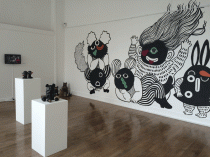
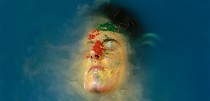
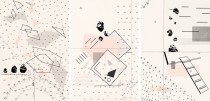









Comments